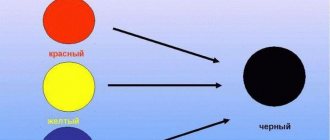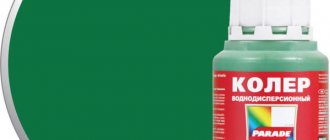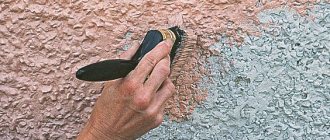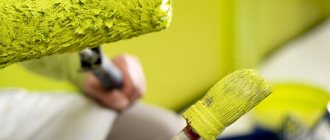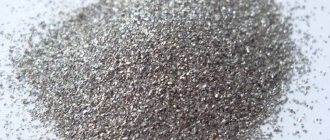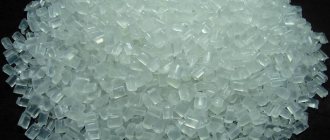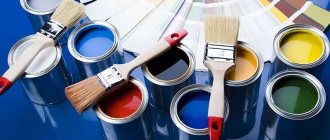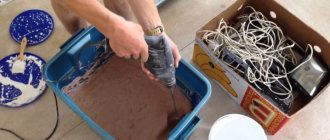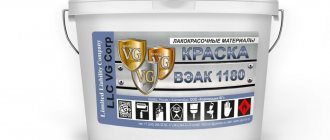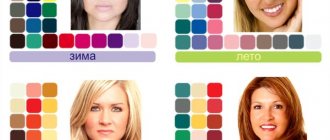You can often find that different types of paints are sold in the same color, standard white. But this does not mean that it will not be possible to obtain the desired shade; tints are used to change the color; they can have a variety of effects. To choose the best option and mix the color correctly, you should understand the nuances of the work. The types and rules for using paint colors will be discussed in detail below.
What is tinting
What is color and the tinting process? This is the action of combining two colors in order to obtain a certain shade. To obtain the enamel of the desired shade, the pigment is manually mixed with the coloring base, gradually adding dye until the desired option is obtained. Or a software selection is used, where a person sets the desired tone, and a special system prescribes the exact ratio of components to achieve the desired result.
Tinting is the action of combining two colors in order to obtain a certain shade.
Types of colors by composition
One of the conditions for dividing colors is what components are added during production. So in this variety there are organic and inorganic types.
The organic option helps produce richer, more vibrant colors. The range of shades is rich, you can easily choose the one you need, but the look also has a minus - such a coating will not have high resistance to light, fading will occur quickly. Also noted as a disadvantage is poor compatibility with mineral-type plaster mixtures, due to the presence of alkalis in the mixture.
The second type is distinguished by better resistance to ultraviolet exposure and durability of the brightness of the shade. But the initial saturation is less pronounced, there are not as many color options as in the previous form.
These features make it logical to conclude that an organic base is the best option for painting surfaces where the lighting is artificial for a large amount of time, for example in the kitchen. Inorganic for substrates that are frequently exposed to ultraviolet light.
One of the conditions for dividing colors is what components are added during production.
In Dahl's dictionary
m. German horse disease, varying in seizures, but in general, a type of rabies; he would. h. incurable; sometimes it comes only temporarily, e.g. when the horse gets warm from riding; sometimes it looks like epilepsy, etc. KOHLER m. French. color or paint; suit; painters use this word to mean the color of the paint, its shade or thickness, the degree of brightness. Colourful, related to color scheme. Colourful, bright in colours. Tint a picture, paint with a brush. Wrongly said. to color, to graft, and to clear, to brighten. A painter is a painter who paints something. Coloring is a way of combining colors in painting. The color is dark, bright, muddy, etc. Colorful, related to color. Colorful, bright colors, brightly and skillfully painted. A colorist is a painter who skillfully arranges paints.
Types of colors by release form
To tint paints at home, you should select the pigment carefully, so you should study the types of products according to the form. It is this difference that largely determines the result obtained and the efficiency of mixing the components. So there are three types:
- Paste-like, can be universal and used on various painting materials, nitro enamels, water-based enamels and others. Dilution is convenient, but it takes a long time to select the desired shade; there is no tinting table that could make the process of working with pastes easier. After drying, the tone may change from dark to light. To avoid mistakes, paint a small area before completely painting the wall;
Paste-like, can be universal and used on different coloring materials. - Dry, low price.
Before adding it to the paintwork material itself, it is necessary to transfer the product from a dry form to a liquid state. For example, for oil paint, drying oil will serve as the basis for the color; there are also few color solutions; Before adding it to the paintwork material itself, it is necessary to transfer the product from a dry form to a liquid state. - Liquid types can have different elements in their base; they are produced for a specific type of paint. It is selected according to the same principle. For example, there are water-based, acrylic-based, and alkyd-based products.
Liquid types can have different elements in their base; they are produced for a specific type of paint.
Manufacturers of dyes for acrylic paint
There is a huge selection of colors made in Russia, America, China and Europe. There are more universal compositions that are suitable for various paints, there are those that are mixed only with water-based, oil-based, alkyd and other paints of a specific composition. Colors that are suitable for acrylic paints are intended for coloring water-dispersion bases.
For example, well-known manufacturers of tints that are suitable for tinting acrylic are:
Dufa. High quality color made in Russia. It is a liquid based on synthetic resins. Offers a huge palette of colors and is suitable for all water-dispersion paint compositions, including acrylic. It has high light resistance and is therefore suitable for both indoor and outdoor use.
Luxens. This color is easy to find in hardware stores, such as Leroy Merlin. More budget-friendly than Dufa, at the same time, in addition to water-dispersion paints, it is suitable for working with alkyd and other types of paints. A distinctive feature of this brand is the use of the ready-made mixture only for interior work.
Parade. Russian manufacturer produces water-dispersed liquids and pastes. Suitable for tinting all water-dispersed compositions, including putty and decorative plaster. Universally suitable for both external and internal work. The manufacturer positions these colors as environmentally friendly materials, so they can be used to renovate children's rooms.
These are not all companies that produce colors for acrylic paints. Click if you are interested in exploring other color manufacturers.
Colors suitable for acrylic paint
Compatibility of colors with various types of paints and other compositions
When they decide to do the painting themselves, beginners regularly ask whether all paintwork materials can be tinted. And what type of colored substance is desirable to use. The color palette can be used for almost all types of paint and varnish products; it is also permissible to use them for varnishes and primer solutions, if such a change in the solution is required to implement the design.
However, it is important to monitor how much product is poured in, otherwise it is easy to get the wrong shade and spoil the white base with color. It is important to correctly calculate the amount added to the composition.
Excess pigment sometimes leads to a deterioration in the adhesion of paints to the base.
In order not to make a mistake and not spoil all the paint, take into account the mixing standards:
- In types with a water base, it is allowed to add no more than 20% of the coloring matter;
- Oil based - one and a half to two percent;
- For other types, up to 5% of the total volume is added.
Compliance with these parameters will help to avoid changes in the properties of paint and varnish products.
It is important to monitor how much product is poured in, otherwise it is easy to get the wrong shade and spoil the white base with color.
Acrylic paints
The color for acrylic paint can be selected from all available types according to the release form. They can also be used with an organic or inorganic base. Inorganic ones are best used as a color for façade paint. Organic ones are available in different colors: red, beige, yellow, gold, ivory, light green, blue and others. It is possible to obtain unusual effects, for example, mother-of-pearl.
The product can be administered in an amount of 8% of the total volume; the amount cannot be exceeded.
The color for acrylic paint can be selected from all available types according to the release form.
Water-based paints
Any color can be chosen for water-based paint. In order to correctly mix the product with the color, you need to understand in advance how to achieve the desired effect. Thus, companies producing products offer a catalog of colors, where it is easy to choose the right option.
If you want to use an unusual shade, it is better to refer to the color chart created for tinting paints. It clearly describes how the required result is achieved.
Companies producing products offer a catalog of colors, where it is easy to choose the right option.
Methods for selecting colors
Kohler is an enamel with a rich color that is used to create a shade of your choice. It consists of pigments, special additives, fillers, synthetic resins, and water.
Colors are used for white enamels, decorative plasters, putties, water-dispersion, alkyd paints.
Sometimes, to create a bright pattern, undiluted color is used without adding base paint to highlight elements of the facade or certain areas of it.
The variety of color options does not allow you to quickly make a choice, and therefore manufacturers offer the use of color standards. 2 scales are used, which help to produce coloring at a high level.
RAL and NCS are the main scales that are used to select a color palette.
RAL includes 210 shades, and NCS - 1950 colors. Some manufacturers develop their own color scale, but, regardless of the selection method, you need to select the desired color option in advance. You can choose a shade if you compare the sample with the wall surface.
With the help of color, it is possible to obtain unique shades for finishing facades, because you can mix shades of different colors and in different proportions. Colors can be mixed with nitro enamels, alkyd and water-dispersion enamels. The color palette will please everyone.
You can select the color manually, but it is difficult to prepare the same shade when re-making the mixture. The selection can be made using a computer, special tinting machines that are available in construction shopping centers, or a catalog.
To carry out the work, manual and automatic dispensers and electric drills are used for mixing compositions. If the painting area is large, then complex numerical control equipment can be used.
All types of surfaces can serve as a basis for painting: brick, concrete, plastered.
Options for proportions and the main advantages of colors
The tinting paste contains a pigment that gives a bright shade. You can create rare and interesting color schemes.
You can create shades yourself by mixing several shades of different colors in different proportions, because there are not a very large number of color options in stores.
The question of how to tint paint is asked by many people who decide to make the facade of their house colored, painted in a rare color. It makes sense to do tinting if the amount of work is small and the solution is prepared 1 or 2 times.
Tinting is a simple process, but there are a number of things to consider. It is necessary to observe the correct dosage, because inaccuracies in mixing the composition can lead to changes in the shade and texture of the mixture.
Before starting work, the color is diluted with water, and then mixed and added to the white base, which must also be thoroughly mixed. It should be taken into account that enamels after drying have a different shade than in their raw form.
Basic proportion options
To obtain a color intensity of 10%, you need to mix 1 kg of paint and 100 g of color, and for an intensity of 5%, use 50 g of color per 1 kg of white base. There are 2 types of colors sold in stores: a colorant with rich, bright colors and a liquid color that creates pastel shades.
The amount of pigment should be: in water-based paint - no more than 20%, in oil paint - no more than 1.5%, and in other types of paints - up to 7% of the color.
The color contains inorganic and organic pigments that have different properties. It’s good if the pigment combines both types.
Organic pigments have bright shades, but fade in the sun, while inorganic pigments are resistant to natural factors, but do not have a bright color range.
The main advantages of tinted paints:
- long service life;
- resistance to abrasion and fading;
- color brightness;
- affordable price;
- large palette of colors;
- saving money.
Paint tinting is needed when you are not satisfied with the color scheme offered in stores. Effectiveness and sophistication can be given to the facade if you paint it with tinted enamel with carefully selected shades.
Methods for tinting LKS
It is possible to tint manually and using special equipment. The first option is more complicated. Automatic mixing makes it possible to accurately obtain a given shade; the equipment itself will determine the amount of pigment and mix the components.
Similar machines are available in paint stores and from manufacturers, where you can place an order for the desired shade. When working, you should keep in mind that each brand has its own color catalog, and they differ from each other.
Automatic mixing makes it possible to accurately obtain the desired shade.
Tinting methods
There are two ways to mix base paint with color: manually and using computer systems. Each method has its pros and cons.
When mixing by hand, the color is added to the paint in small portions, and the color is created “by eye.” You don’t need any complicated equipment for this, plus you can tint the paint anywhere. Accordingly, this method is good for preparing a small portion of paint that can be used immediately. This method is not suitable for mixing paints in large quantities and in several steps, since when creating subsequent portions it is almost impossible to achieve the original color.
Manual method of mixing color Source bauemotion.de
Kneading by hand
Manual tinting involves preparing the necessary materials; you will need containers and means for mixing. Then the following steps are performed:
- According to the color table, the required amount of the component is added.
- The base is poured into the container, where a measured amount of product is gradually added, they begin to mix by hand, then proceed to mixing with a mixer until smooth.
- It is important to write down the given amount of product; if there is not enough to paint the entire surface, you will need to repeat the process.
- Test the color on an inconspicuous area.
It is important to write down the given amount of product; if there is not enough to paint the entire surface, you will need to repeat the process.
Independent work on obtaining the desired color
When mixing independently, take into account that it is advisable to prepare the color in sufficient quantities for the entire room. Otherwise, it may no longer be possible to accurately replicate the shade. Be sure to check what color came out in a small area. After drying, the final result will appear, and in artificial light it looks different than in sunlight.
When mixing independently, take into account that it is advisable to prepare the color in sufficient quantities for the entire room.
Coloring technology
You can get black or another color manually, if you calculate the consumption in advance. To calculate, it is better to look at the tinting table. But the data in them is imperfect and may vary depending on the means used.
To calculate, it is better to look at the tinting table.
Rules for calculating colors
Based on the specified parameters, the quantity per volume of paint is calculated. According to the manufacturer's data, the required number of drops is multiplied by the kilograms of paint that will be used. This is how you get the answer on how many drops to administer.
Based on the specified parameters, the quantity per volume of paint is calculated.
Mixing components - step-by-step instructions
Gray, green, yellow and any other colors can help you get the desired color scheme, but it is important to proceed step by step:
- It is recommended to stir a small amount of components first so as not to spoil all the paint.
- After testing the resulting color, you can repeat mixing with the entire volume. The color is introduced gradually.
It is recommended to stir a small amount of components first so as not to spoil all the paint.
Tinting systems
In the painting world there is such a thing as tinting systems. This is the use of base paint and color. Colors are deep or opposite colors. The pigments that make up them are organic or inorganic. Organic pigments are typically used for richer shades.
But such pigments have the following disadvantages:
- not every surface can be coated with this composition;
- paint with such pigments is short-lived; under sunlight it will fade over time.
Colors with inorganic pigments have a limited color range, but they are not afraid of the influence of atmospheric phenomena.
The production of colorants is carried out in different versions:
- pastes,
- paints,
- dry mixes.
The paste contains dispersing resins; it is also possible to have a type of paste where there is no substance used for bonding.
There are different types of pastes - there are universal ones that are suitable for any paint, and there are specialized pastes designed for specific paint materials. The pastes are easy to use; when mixing, you can easily adjust the desired shade. But they have disadvantages: the pastes do not have formal properties of color and saturation. The final shade may be unexpected for you.
The composition of tinting paints does not differ from the paints and varnishes for which they are used:
- water emulsions,
- acrylic,
- oil
- others.
By combining white paint and pigments, you will get the color you need. If you need a very bright and saturated color, then the existing colorant does not need to be diluted.
The advantage of dry compounds is their low price. But the color range of such pigments is very narrow, and correcting the desired shade is very difficult, since such pigments should not be added to a color mixture that is ready for use.
Small tips
When choosing, you can take into account the advice of experts. Thus, manufacturers often prescribe the purpose of products for floors, ceiling coverings, etc., the recommendation is taken into account.
If the place where you decided to purchase the color did not have the desired option, then you should not mix the colors in the store; they may look different in the house. It is better to choose a container with a neck, it serves as a measuring element. The product should be stored in a tightly closed container.
If the place where you decided to purchase the color did not have the desired option, then you should not mix the colors in the store; they may look different in the house.
What is color required for?
Thanks to the use of color, you will be able to realize the most daring design ideas regarding the design of your home.
Tinting can be carried out on a variety of surfaces - brick, concrete, wood, plasterboard, chipboard and fiberboard. It is also possible to apply the coloring compound to plaster.
The use of color is required in the following situations:
- the initial coating has minor unevenness;
- it is necessary to choose a tone that is in harmony with the color scheme of the existing environment;
- interior design involves decorating in several tones of the same color;
- There were errors when calculating the volume of paint or the required color is out of stock.
"Recipes" of the most popular shades
To make it easier to obtain the chosen shade, you can turn to ready-made recipes for popular colors. So tomato red is obtained by mixing red with yellow and brown (colors make up 5%). Turquoise blue is made from blue with 10-15% green. Burgundy - 5-10% of brown, yellow, black is added to red (but the percentage is the same for all colors except the base).
To make it easier to obtain the chosen shade, you can turn to ready-made recipes for popular colors.
Tinting can be done by hand, but the process requires concentration and care. To obtain the chosen color, the color scheme and proportions are selected with special attention. It’s easier to turn to professionals who have special equipment.
DIY paint tinting
What you will need for this process is a container of the mixture, a drill with an attachment, a small reservoir for placing a test portion, white base paint, and color scheme.
Tinting stages:
- Preparing a test portion. Before making a large volume of the mixture, test a small portion. Otherwise, you just might ruin all your material. Pour some paint (100 ml) and a few drops of the color mixture into our small reservoir. When you get the shade you need, remember how many drops you added.
- Carrying out experimental tests on the working surface. As we already mentioned, the color on the surface may be different from the color of your mixture. Therefore, we take our test dose and try it on a small area of the work surface. We wait for it to dry and see what happens. Keep in mind that different lighting will give different shades.
- Production of the main volume of material. If you are completely satisfied with what came out in the trial version and on the work surface, then you can proceed to the main volume. How to calculate the required amount of color? Subtract 20% from the trial doses received. That is, if you added 7 drops of one color and 2 of the other to the sampler, then per liter of paint you will need not 70 and 20 drops, but 56 and 16 drops. When the mixture is evenly stirred, test the surface again. Don't forget about different lighting.
The main thing is not to rush when tinting. Take your time and achieve the desired result. Otherwise, you risk ruining all your existing materials, or achieving a color that doesn’t suit you. Please note that it is better to prepare more paint than is needed.
If you don’t have enough paint, choosing exactly the right shade is a very difficult task. And, most likely, the shades in different containers will differ. The remaining amount will be useful to you in the future, when the time comes for corrective repairs. Pour the excess into a jar and close the lid tightly.
You need to tint large paints in one container, otherwise, if you need to repeat the shade, you will have difficulty calculating the required volume. When you are faced with a choice of color, it is better to choose one contained in bottles with a narrow neck - it is more convenient to calculate the number of drops. If you choose another one, you can use a syringe for these purposes.
In order to select the desired color and the amount of color required, you can use a special table for mixing colors.
To ensure that the resulting material is evenly mixed, attachments of various sizes can be attached to the drill.
It is better to choose paint and color from the same company, this guarantees the achievement of maximum results when mixed. As a rule, the color scheme comes with information about the required volume of base paint.
When painting an apartment, study the color scheme in advance. It is known that some colors have a calming effect on a person, while others, on the contrary, cause irritation and aggression.
Table. Mixing colors.
| Color name | Mix to get it |
| Pink | 90% white + 10% red |
| Royal red | 5-10% blue is added to red |
| Tomato red | Add 5% brown and yellow to red |
| Crimson | Blue base + a little white, brown and red in equal proportions |
| Chestnut | Add 5% brown and 3% black to red |
| Red | If you want to lighten red, add white |
| Orange | Add up to 30% red to yellow |
| Yellow | Yellow - lighten with white, darken with red and brown |
| Olive | Green base + 10-20% yellow |
| Turquoise green | Add up to 25% blue to green |
| Bottle green | Yellow + 20-40% blue |
| Turquoise blue | In blue 10-15% green |
| Royal blue | In blue 10-15% black and 2% green |
| Dark blue | Blue + 5% black and 2% green |
| Grey | In white to 5% black |
| Medium brown | Add red and blue to yellow in equal portions, add white if you want to lighten it, darken it with black. |
| Golden brown | To yellow we add 10% blue, white and red, the more yellow, the higher the contrast. |
| Mustard | In yellow, 5% black and red + 1-2% green |
| Beige | Add white to brown while stirring until the desired tone is obtained, add yellow for brightness |
| Pink gray | In white up to 5% black or red |
| Gray-blue | In white up to 5% light gray + 1% blue |
| Green-gray | In white 5% light gray + 1% green |
| Gray coal | Black is added to white until the desired tone is achieved (with constant stirring) |
| Lemon yellow | In yellow 5% white and 1-2% green |
| Fern green color | Add black, green and white paint in equal parts to white |
| Forest green color | Green is diluted with black (up to 5%) |
| Emerald green | Yellow diluted with white (less) and green (more) paint |
| Light green | Yellow is diluted with white (5%) and green (10%) paint |
| Aquamarine | Add up to 35% green and 5% black to ball paint |
| Avocado | Add black and brown paint to yellow in equal parts (up to 10%) |
| Royal purple | Red color is diluted with yellow and blue paint |
| Dark purple | We dilute the red tone with black and blue paint |
| Mandarin, orange | In yellow paint up to 10% red and up to 5% brown |
| Reddish chestnut | Red is diluted with black and brown |
| Orange | White diluted with red and brown |
| Burgundy red color | Add 5-10% yellow, brown and black paint to red paint in equal parts |
| Plum | In red, 10% black and blue and 5% white |
| Chestnut | Add white, red and black paint to yellow in equal proportions |
| Dark brown | In yellow paint 10-20% each of red, white and black |
| Black | Black is lightened to different shades of gray with white |
